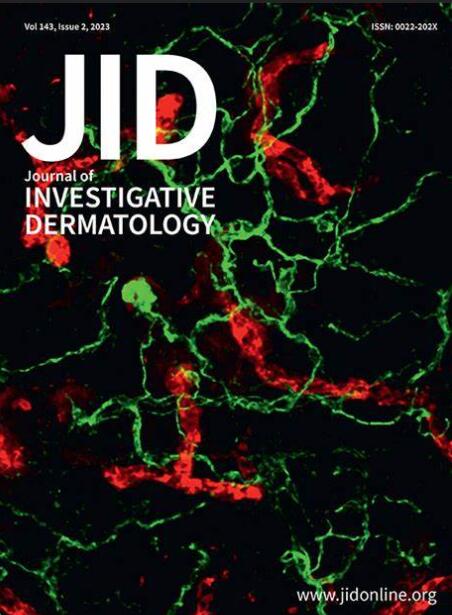抑制脂肪细胞衍生的脂肪酸结合蛋白4可减少脂肪细胞炎症,改善血管生成,并促进代谢功能障碍患者的伤口愈合。
IF 5.7
2区 医学
Q1 DERMATOLOGY
引用次数: 0
摘要
真皮白色脂肪组织可能参与伤口愈合过程。肥胖介导的慢性低度炎症会抑制血管,从而损害伤口愈合。鉴于脂肪酸结合蛋白(FABP)4在肥胖动物的皮肤组织中上调,本研究旨在探讨抑制FABP4对高脂饮食(HFD)诱导的代谢功能障碍小鼠体内伤口愈合的影响。研究还探讨了脂肪细胞衍生的 FABP4 与血管内皮细胞功能之间的相互作用。在高密度脂蛋白饮食诱导的代谢功能障碍小鼠中,抑制 FABP4 可增加血管生成,促进伤口愈合,减少伤口发炎。抑制 FABP4 不仅能减轻全身炎症、降低体重和胰岛素抵抗,还能改善脂肪细胞的大小和真皮白色脂肪组织的缺氧状况。体外缺氧诱导脂肪细胞炎症,缺氧刺激脂肪细胞的上清液损害了人真皮微血管内皮细胞的功能和血管生成能力。抑制 FABP4 可改善这两种情况。总之,抑制 FABP4 可减轻全身炎症和脂肪细胞炎症,改善血管内皮细胞功能,促进新陈代谢功能障碍的伤口愈合。鉴于伤口愈合的复杂性,未来的研究可能需要验证 FABP4 作为代谢功能障碍患者伤口修复的潜在治疗靶点。本文章由计算机程序翻译,如有差异,请以英文原文为准。
Inhibition of adipocyte-derived fatty-acid-binding protein 4 reduces adipocyte inflammation, improves angiogenesis, and facilitates wound healing in metabolic dysfunctions.
Dermal white adipose tissue may participate in the wound healing process. Obesity-mediated chronic low-grade inflammation impairs wound healing by suppressing vascularity. Given that fatty-acid-binding protein (FABP) 4 is upregulated in the skin tissue of obese animals, this study aimed to investigate the effects of FABP4 inhibition on wound healing in high-fat-diet (HFD)-induced metabolic dysfunction mice in vivo. The interaction between adipocyte-derived FABP4 and vascular endothelial cell function was also investigated. In HFD-induced metabolic dysfunction mice, FABP4 inhibition increased angiogenesis and facilitated wound healing with reduced wound inflammation. FABP4 inhibition not only attenuated systemic inflammation, decreased body weight, and reduced insulin resistance, but also improved the sizes of adipocytes and hypoxic conditions in dermal white adipose tissue. The in vitro hypoxia was used to induce adipocyte inflammation, and the supernatants from hypoxia-stimulated adipocytes impaired the function and angiogenetic capability of human dermal microvascular endothelial cells. Both of them were improved by FABP4 inhibition. Altogether, FABP4 inhibition reduced systemic and adipocyte inflammation, improved vascular endothelial cell function, and facilitated wound healing in metabolic dysfunctions. Given the complex involvement of wound healing, future studies may be required to validate FABP4 as a potential therapeutic target for wound repair in metabolic dysfunctions.
求助全文
通过发布文献求助,成功后即可免费获取论文全文。
去求助
来源期刊
CiteScore
8.70
自引率
4.60%
发文量
1610
审稿时长
2 months
期刊介绍:
Journal of Investigative Dermatology (JID) publishes reports describing original research on all aspects of cutaneous biology and skin disease. Topics include biochemistry, biophysics, carcinogenesis, cell regulation, clinical research, development, embryology, epidemiology and other population-based research, extracellular matrix, genetics, immunology, melanocyte biology, microbiology, molecular and cell biology, pathology, percutaneous absorption, pharmacology, photobiology, physiology, skin structure, and wound healing

 求助内容:
求助内容: 应助结果提醒方式:
应助结果提醒方式:


